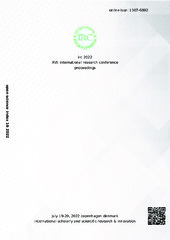Приказ основних података о документу
Evaluation of Herbal Extracts for Their Potential Application as Skin Prebiotics
| dc.creator | Petrov Ivanković, Anja | |
| dc.creator | Veljković, Milica | |
| dc.creator | Ćorović, Marija | |
| dc.creator | Milivojević, Ana | |
| dc.creator | Simović, Milica | |
| dc.creator | Banjanac, Katarina | |
| dc.creator | Bezbradica, Dejan | |
| dc.date.accessioned | 2023-03-08T13:33:07Z | |
| dc.date.available | 2023-03-08T13:33:07Z | |
| dc.date.issued | 2022 | |
| dc.identifier.issn | 1307-6892 | |
| dc.identifier.uri | http://TechnoRep.tmf.bg.ac.rs/handle/123456789/5996 | |
| dc.description.abstract | One of the fundamental requirements for overall human well-being is a stable and balanced microbiome. Aside from the microorganisms that reside within the body, a large number of microorganisms, especially bacteria, swarming the human skin are in homeostasis with the host and represent a skin microbiota. Even though the immune system of the skin is capable of distinguishing between commensal and potentially harmful transient bacteria, the cutaneous microbial balance can be disrupted under certain circumstances. In that case, reduction in the skin microbiota diversity, as well as changes in metabolic activity, result in dermal infections and inflammation. Probiotics and prebiotics have the potential to play a significant role in the treatment of these skin disorders. The most common resident bacteria found on the skin, Staphylococcus epidermidis, can act as a potential skin probiotic, contributing to the protection of healthy skin from pathogen colonization, such as Staphylococcus aureus, which is related to atopic dermatitis exacerbation. However, as it is difficult to meet regulations in cosmetic products, another therapy approach could be topical prebiotic supplementation of the skin microbiota. In recent research, polyphenols are attracting scientists' interest as biomolecules with possible prebiotic effects on the skin microbiota. This research aimed to determine how herbal extracts rich in different polyphenolic compounds (lemon balm, St. John's wort, coltsfoot, pine needle and yarrow) affected the growth of S. epidermidis and S. aureus. The first part of the study involved screening of plants to determine if they could be regarded as probable candidates to be skin prebiotics. The effect of each plant on bacterial growth was examined by supplementing the nutrient medium with their extracts and comparing it with control samples (without extract). The results obtained after 24 h of incubation showed that all tested extracts influenced the growth of the examined bacteria to some extent. Since lemon balm and St. John's wort extracts displayed bactericidal activity against S. epidermidis, whereas coltsfoot inhibited both bacteria equally, they were not explored further. On the other hand, pine needle and yarrow extract led to an increase in S. epidermidis/S. aureus ratio, making them prospective candidates to be used as skin prebiotics. Byexamining the prebiotic effect of two extracts at different concentrations, it was revealed that, in the case of yarrow, 0.1% of extract dry matter in the fermentation medium was optimal, while for the pine needle extract, a concentration of 0.05% was preferred, since it selectively stimulated S. epidermidis growth and inhibited S. aureus proliferation. Additionally, total polyphenols and flavonoids content of two extracts were determined, revealing different concentrations and polyphenol profiles. Since yarrow and pine extracts affected the growth of skin bacteria in a dose-dependent manner, by carefully selecting the quantities of these extracts, and thus polyphenols content, it is possible to achieve desirable alterations of skin microbiota composition, which may be suitable for the treatment of atopic dermatitis. | sr |
| dc.language.iso | en | sr |
| dc.publisher | The world academy of science, engineering and technology | sr |
| dc.relation | info:eu-repo/grantAgreement/ScienceFundRS/Ideje/7750109/RS// | sr |
| dc.rights | openAccess | sr |
| dc.rights.uri | https://creativecommons.org/licenses/by/4.0/ | |
| dc.source | XVI. international conference on advances in probiotics and prebiotics, Copenhagen Denmark, Proceedings | sr |
| dc.title | Evaluation of Herbal Extracts for Their Potential Application as Skin Prebiotics | sr |
| dc.type | conferenceObject | sr |
| dc.rights.license | BY | sr |
| dc.citation.spage | 84 | |
| dc.identifier.fulltext | http://TechnoRep.tmf.bg.ac.rs/bitstream/id/15913/bitstream_15913.pdf | |
| dc.identifier.rcub | https://hdl.handle.net/21.15107/rcub_technorep_5996 | |
| dc.type.version | publishedVersion | sr |

